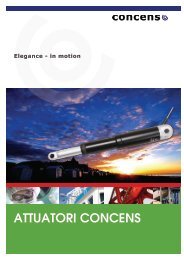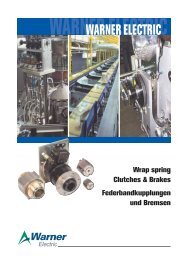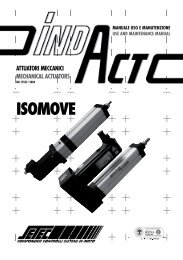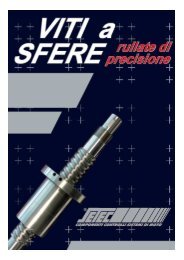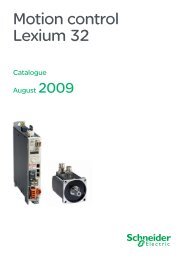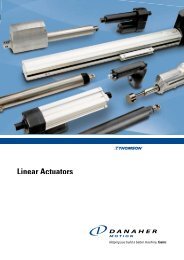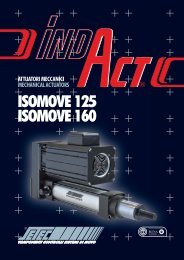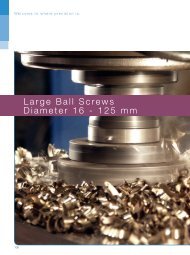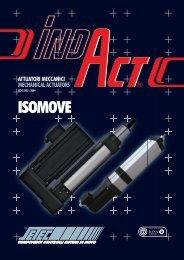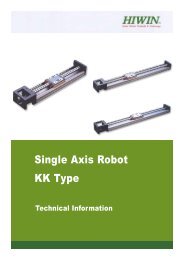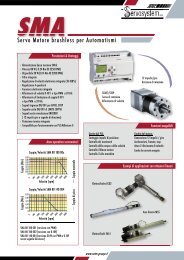You also want an ePaper? Increase the reach of your titles
YUMPU automatically turns print PDFs into web optimized ePapers that Google loves.
<strong>WARNER</strong> <strong>WARNER</strong> <strong>ELECTRIC</strong>TensionControlSystems
Tension Control Systems<strong>WARNER</strong> <strong>ELECTRIC</strong> offers the mostcomplete product line dedicated tothe TENSION CONTROL MARKET.The long experience in the market ledus to develop high performance controlsable to operate in open and closed loopwith brakes and motors. <strong>WARNER</strong><strong>ELECTRIC</strong> electromagnetic brake findan optimum use in tension control whenassociated with the new digital controlline.ABOUT THIS CATALOGUEThis master catalogue groups allthe solutions / products that<strong>WARNER</strong> <strong>ELECTRIC</strong> offers. Animportant part is dedicated to thesolution design with particularconsideration regarding the machineand the tension control installed.This should help you for the rightsolution choice taking in considerationthe results you want to achieve.All the product characteristics anddimensions are included for everyproduct.Applying the appropriatedTension Control will lead you■ To save material■ To improve quality of theoperation■ To increase the production■ Finally to lower your productioncostASK <strong>WARNER</strong> <strong>ELECTRIC</strong>FOR ANY ASSISTANCE YOUWOULD NEED2
IndexMARKET / SOLUTION413❐ Tension control definition❐ Tension control applied❐ Tension control in open loop❐ Tension control in closed loop❐ Torque and power determination❐ Configuration selection❐ Closed loop – sensor selection❐ Open loop – setting selection<strong>WARNER</strong> BRAKE RANGES14 21❐ Tension brake overview❐ Tension brake sizing❐ Tension brake for strappingmachine❐ TB brake selection/characteristicsDRIVERS❐ For electromagnetic brakes22CONTROLS23 33❐ Closed loop control overview❐ MCS202-E line❐ MCS2000 line configuration❐ MCS2000 line characteristics❐ MCS2000-ECA❐ MCS2000-CTDA/CTLC❐ MCS2000-important features❐ Open loop control MCS2000-CTOL❐ MCS2000 control line dimensionsSENSORS / ACCESSORIES34 40❐ Sensors overview❐ End shaft load cell type ES❐ Foot mounted load cell type FM❐ Rotary sensors❐ Linear sensor❐ MCS2000 line - accessories❐ Rotary sensors - accessories❐ All sensors/accessories dimensions3
Tension control definitionMARKET /SOLUTIONBefore going through the various products and solutions <strong>WARNER</strong> <strong>ELECTRIC</strong> canoffer, it is important to make a correct analysis of the need. What we call “need” is thetension control accuracy you need to operate a good material transfer through themachine and realize perfect operation on the material.WHAT’S TENSION CONTROL ?The tension control is the ability to permanently control themechanical tension in any material (mainly the raw materialavailable in roll size). This control has to be operated dynamicallyand statically. On every machine the operator shouldbe only concerned by the speed and operation. The linespeed is considered as master function. The tension controlmust be efficient at any machine speed phase, includingmachine acceleration, steady and speed deceleration.Emergency stop case does not require accurate tensioncontrol but should act in the way to avoid the web breakage.It is then very important to consider all machine speedphases for the system determination.WHY A TENSION CONTROL ?When web material has to be treated in a specific machine(printer, slitter, coater….) it is very important to transport theweb with a controlled tension for two main reasons :❐ Correct web transport in the machine❐ Correct operation on the transported materialOn the other hand, this kind of machine works very oftenwith an “edge guiding system”. Loosing the tension inmaterial will affect the correct edge guiding system.WHERE DOES IT APPLY ?In any roll fed web processing machine. Typically :❐ PRINTING machine❐ LAMINATING machine❐ SLITTING machine❐ SHEETING machine❐ COATING machine❐ EXTRUDERS❐ Stand alone UNWINDER / REWINDER❐ In general all CONVERTING equipmentTreating material such as:❐ Paper❐ Plastic film❐ Textile❐ Aluminium foil❐ Wires / cablesIn general in all machines whose block diagram can berepresented as follows:4
Tension control applicationMARKET /SOLUTIONAnalysing and preparing a project in tension control requires good analysis support.The general block diagram below is a good representation of any machine generallysupporting tension control. We recommend to use this diagram or a part of it in anydiscussion and correspondence in order to be clear and to avoid possible misunderstandings.GENERAL BLOCK DIAGRAMAB CZone 1 Zone 2 Zone 3DX Y ZIMPORTANT CONSIDERATIONIn every machine the speed point location must be clearly identified. In general one of the machine nip roll is driven settingthe linear velocity of the machine. The machine speed is considered as MASTER function. The tension control, whateverthe choosen solution, works in SLAVE mode. Practically, the operator sets the machine speed with a simple potentiometerand all tension control system existing on the machine have to follow, keeping the desired tension at any speed and duringall transitory speed phases.REFERING TO THE GENERAL BLOCK DIAGRAMThree zones are clearly identified :ZONE 1, Typical characteristics(unwind)ZONE 2, Typical characteristicsZone 3, Typical characteristics(rewind)❐ Tension zone definition : A-B❐ Speed point in B❐ Variable roll rotation speed❐ Variable inertia❐ In general constant tension X❐ Brake system applicable❐ Motor system applicable❐ Tension zone definition B-C❐ Speed point in B or C❐ Constant roll rotation speed❐ Constant inertia❐ In general constant tension Y❐ Brake system applicable❐ Motor system applicable❐ Tension zone definition C-D❐ Speed point in C❐ Variable roll rotation speed❐ Variable inertia❐ Constant or Taper tension Z❐ Brake not applicable❐ Motor system requiredNOTE : Each zone is individually controlled. Tension may be different in each zone. It is assumed that there is no slipping on the nip roll.5
Tension control in open loopMARKET /SOLUTIONWorking in open loop requires an external reference setting applied to the driver. Thetorque applied to the unwind roll has to vary according to the diameter of the roll.Open loop solution is generally a low cost solution but with limited accuracy.OPEN LOOP SOLUTIONThe open loop configuration does not require any control or sensor. It is composed only with a power element (brake ormotor) and an associated driver. In this case the torque is not controlled. We have to set the torque on the driver accordingto the diameter of the roll. The electrical block schematic drawn from the closed loop system becomes as follows:Torque settingDriverPowerThe power part is transmitting the necessary torque to theroll. Since the result is not measured, all the effect due tothe inertia of the roll influence the tension in the web. Somecompensations are possible but the system stays an openloop with limited accuracy.THREE POSSIBILITIES TO APPLY THE SETTING❐ MANUAL by potentiometerDriver❐ AUTOMATIC with the diameter readingDriver❐ AUTOMATIC with the diameter calculationTDiamCalculatorDriverThe diameter calculation is based on line and rotation speedinformation.This solution requires to have both information available.TTo summarize, the web tension control can be operated in two system configurations OPEN and CLOSED loop. For eachconfiguration, three main possibilities for SETTING respectively SENSING are possible. The solution choice depends on :❐ First the accuracy you need in your web tension❐ The mechanical construction of the machine❐ The degree of automation you need❐ The acceleration/deceleration imposed on the systemIn the next section <strong>WARNER</strong> <strong>ELECTRIC</strong> gives you some criteria to facilitate your choice. It’s not our intention to impose asolution but just to offer a guide drawn from the <strong>WARNER</strong> <strong>ELECTRIC</strong> experience. We put the accent on the limit ofvarious possibilities in order to start your project on a healthy base and really get the result you are expecting.6
Tension control in closed loopMARKET /SOLUTIONTo create a tension it is necessary to apply a force or more precisely a torque whenapplied to a turning part. <strong>WARNER</strong> <strong>ELECTRIC</strong> is manufacturing a wide range ofbrakes from fractionnal Nm to thousands of Nm. Two main solutions exist in terms ofsystem configuration to apply the right torque:❐ Closed loop control.❐ Open loop control (or more precisely open loop setting).CLOSED LOOP SOLUTIONThe tension control, as any electronic control, is working basically in closed loop according the electrical block diagrambelow. In closed loop we sense the result we want to achieve and compare it with a reference in order to ensurepermanent balance between what we want and what we have.Reference(What wewant)Control Driver Power Sensor(Brake or Motor)Feedback (What we have)Reported as example of an unwind standSensorThe closed loopPower Driver ControlReferenceThe closed loop is an electrical/mechanical loop.It’s easy to understand that in such a loop all partsare important in terms of quality.❐ The control – has to have high performance tomanage all parameter changes correctly duringthe operation.❐ The driver – has to be as fast as possible interms of response.❐ The power part – has to be sized correctlyaccording to the need and as fast as possiblein terms of response.❐ The sensor – has to be accurate, stable overtime and to have a good repeatability.The quality of the mechanical construction is important. The control loop is closed through the mechanical transmissionbetween the power element and the sensor roll. The web itself is a part of the loop. In the case of webs with highelasticity, special consideration should be given in control setting.THREE WAYS TO SENSE THE TENSION❐ Direct tension measurementwith LOAD CELL.❐ Indirect tension measurementwith DANCER ARM.❐ Indirect tension measurementwith FREE LOOP.7
Torque and power determinationMARKET /SOLUTIONLet’s take, as an example, a complete slitter-rewinder machine in order to establish acomplete “power balance” sheet about the torque. The power we need in the threemachine zones is the following:❐ Unwind part (zone 1)❐ Machine process part (zone 2)❐ Rewind part (zone 3)“POWER” FROM MOTOR OR BRAKE ?Based on two parameters :❐ Do I need a positive torque or is a negative torque sufficient ?❐ Which technology is on the machine ?In the case where the “torque need” calculation shows positive results weare forced to use a motor. Only a motor is able to provide positive torque.It’s typically the case on the rewind stand. On the other hand, for the unwindstand the brake solution very often suits the requirements.The technology parameter is purely a customer decision. The tensioncontrol with motor is today operated with AC motor and flux vector controldrive with full power regeneration in the line.<strong>WARNER</strong> <strong>ELECTRIC</strong> offer both solutions with a wide range of products.TORQUE NEED EVALUATIONExample of calculation on a typical machine (slitter / rewinder).XUnwind1 2 Slitter3 3standYRewindstandsParameters givenUnwind tension zone X 250 NRewind tension zone Y 100 N, all rollsTaper tension zone Y 40%Max unwind roll diam. 1 mMax rewind roll diam. 0,5 mMin unwind roll diam. 0,09 mMin rewind roll diam. 0,06 mMax line speed 400 (m/min)Accel50 m / min / secDecel150 m / min / secMax unwind roll weight 500 KgMax rewind roll weight 80 Kg, all rollsUnwind stand (zone 1)Max torque to provide the tension - 1 m * 250 N / 2 -125 NmMin torque to provide the tension -0,09 m * 250 N / 2 -11,25 NmInertia of the full roll 0,5 * 500 Kg * 0,5 m * 0,5 m 62,5 Kgm 2Max rotation speed (at full line speed) + (400 m/min / 0,09m / 3.14) +1415 rpmMin rotation speed (at full line speed) + (400 m/min / 1m / 3,14) +127 rpmTorque to accelerate the full roll + (62,5 Kgm 2 * 127 rpm / 9,55 / 8 sec) +104 NmTorque to decelerate the full roll - (62,5 Kgm 2 * 127 rpm / 9,55 / 2,66 sec - 312 NmTorque need on the roll to insure correct tension- In acceleration - 125 Nm + 104 Nm -21 Nm- During steady speed for D to d -125 Nm to -11,25 Nm -125 to -11,25 Nm- In deceleration -125 Nm - 312 Nm -437 Nm- Max continuous power dissipated - 125 Nm * 127 rpm / 9550 -1,66 kWThe torque need for each machine phase shows a negative result. Brake and motor can comply with all parameters.Whatever the choice the selection must be based on the max requirements of heat, torque and speed.8
Torque and power determinationMARKET /SOLUTIONRewind stand (zone 3)Both shafts are similar in terms of mechanical parameters. It’s practically always the case for slitting machines.Max torque to ensure the tension (biggest diameter, all rolls) +(0,5 m * 100N * 60% / 2) +15 NmMax torque to ensure the tension (smallest diameter, all rolls) +(0,06 m * 100N / 2) +3 NmMax shaft rotation speed +(400 m/min / 0,06 m / 3,14) +2123 rpm- In reality the max speed in never reached on the core diameter.For the max speed on the core we can assume a practical reduction of 25%Then max rotation speed +(2123 rpm * 75%) +1592 rpmMin shaft rotation speed +(400 m/min / 0,5 m / 3,14) +255 rpm- In reality the full roll is never reached at full speedFor the min speed at full roll we can assume a practical reduction of 25%Then min rotation speed +(255 rpm * 75%) + 191 rpmInertia of the full roll, all rolls 0,5 * 80 Kg * 0,25 m * 0,25 m 2,5 Kgm 2Torque to accelerate the full roll, all rolls +(2,5 Kgm 2 * 191 rpm / 9,55 / 8 sec) + 6,25 NmTorque to decelerate the full roll, all rolls –(2,5 Kgm 2 * 191 rpm / 9,55 / 2,66 sec) – 18,8 NmFinal torque need on the roll to ensure correct tension- In acceleration + 15 Nm + 6,25 Nm + 21,25 Nm- In steady speed for d to D + 3 to + 15 Nm + 15 Nm- In deceleration + 15 Nm – 18,8 Nm – 3,8 Nm- Max power continuous dissipated per shaft + 15 Nm * 255 rpm / 9550 + 0,4 kWMAIN DRIVE NIP ROLL (zone 2)250 N100 N100 NNecessary theoretical power :Worst tension balance = 250 N – (2 * 100 N * 60%) = 130 NMax power need = 130 N * 400 m/min/60 = 867 WMax roll rotation speed : depends of nip roll diameterMACHINE POWER BALANCEUnwind standMain driveRewind shaft (2)TOTAL POWER(due rounded number)– 1,66 kW+ 0,87 kW+ 0,80 kW+ 0,01 kW0,00 kWPlease note it is a theoretical calculation. We did not take all the initialfriction account. Looking at the torque need for each zone we can say:❐ Tension function on unwind stand can be achieved by motor or brake.❐ Nip roll system has to be motor driven.❐ Tension function on rewind shaft must be provided by motor.<strong>WARNER</strong> <strong>ELECTRIC</strong> can offer you the appropriate solution whatever your choice:wide range of electrical brakes as well as motorised solutions.Please see pages 14 to 19 for component selection.9
Configuration - selectionMARKET /SOLUTIONThe power part selection is the same whatever the configuration. As soon as thepower element and its associated drive are defined we have to determine how thesystem will be driven: in open or closed loop ?As previously stated, one important factor is the tension accuracy you need.CLOSED LOOP - ADVANTAGE / DISADVANTAGESensorAdvantageFeedbackMachinewith speedimposed byoperator❐ High accuracy.❐ All initial friction in mechanical parts, even if theyare changing over time are overcome.❐ Tension is controlled during all the machinespeed phase (accel, decel, steady speed).❐ System can work in slave without any electricalconnections to the machine.DisadvantagePower Driver ControlReference❐ Risk of instability.❐ Can be more complex to set-up.❐ More expensive compared to open loop.OPEN LOOP - ADVANTAGE / DISADVANTAGEAdvantagePowerDriverSetting :❐ Manual❐ Diam. measure❐ Diam. computingMachinewith speedimposed byoperator❐ Very stable.❐ Easy to start-up.❐ Low cost compared to closed loop (sensor andcontrol units not required).Disadvantage❐ Poor accuracy❐ Strongly dependent on quality of mechanical parts.❐ Accel, decel phase reflected on tension.DO NOT FORGET : all above considerations - even if example is unwind stand - are applicable to the threevarious machine zones we have defined on page 5.Every zone of the complete machine can be controlled with its own appropriate tension system configuration. A typicalexample is the tension in a printing machine. It is very often controlled on an unwind stand in closed loop where theaccuracy is important for good printing and on a rewind stand in open loop where the tension precision is not so importantafter the print operation.Finally it’s the customer decision. <strong>WARNER</strong> <strong>ELECTRIC</strong> can offer advise in solution and product choice.10
Closed loop - Sensor selectionMARKET /SOLUTIONIf your machine requires a very accurate web tension control, then you need to workin closed loop. An important unit in the loop is the sensor. Three main possibilities areoffered. The choice is now depending on the kind of machine you are building, themechanical construction and the max tension value you desire to control.<strong>WARNER</strong> <strong>ELECTRIC</strong> bring you their experience for selection according various criteria.MAIN APPLICATIONS - ADVANTAGE - DISADVANTAGE FOR THE THREE POSSIBILITIESType of sensor Where, When, Why ? Advantage DisadvantageLoad cell ❐ Slitter, Sheeter, Coater Direct tension measure No tension peak absorption❐ For heavy material Mechanically well integrated Accel/decel machine not❐ Limited room No moving part easy to manage❐ No fast accel/decelFlying splice function❐ Tension peak acceptednot easyDancer arm ❐ Printing Absorb tension peak Need more space❐ Intermittent function Can act as store Moving parts❐ Flying splice need Easy flying spliceAccel / decel machinephase well absorbedFlexibilityFree loop ❐ Textile machine Same as Dancer arm Same as dancer arm❐ Very low tensionReliable position readingnot easy❐ In any cases the machine speed profile is important. The accel/decel machine ramps have to be electrically managed.❐ In any mechanical construction (dancer arm), all the inertia has to be minimized.WrapingangleLOAD CELLS SIZING - MOUNTING RECOMMENDATIONSPlease keep this principle in mind: The load cell installed is destined to measure theWEB TENSION and not other constraints applied to it.Take the following points into consideration before selecting, sizing and installing material components.❐ Load cells location should be vibration free. Vibrations will decrease quality measurement.❐ The sensing shaft fitted on or in has to be very well balanced. Unbalanced shaft will create measurement oscillation,causing variations in control quality.❐ Adapted ball bearing have to be used to avoid original stress on load cell ( self-aligning ball bearing).❐ Respect a reasonnable sensing shaft weight/web tension measure ratio. Less than 1.❐ Do not oversize the load cell respect to your calculation. Max admitted factor 3, recommended 1,5.❐ Respect a minimum wrapping angle on load cell. Min = 240°.❐ So far as it is possible, use load cell in compression, with web tension effect in same direction as the weight of shaft.11
Closed loop - Sensor selectionMARKET /SOLUTIONTTDANCER ARM BUILDING AND OPERATIONALRECOMMENDATIONSPDancer arm system is used for indirect tension measurement. It is in fact aposition control. The desired tension in web is provided with an externalcomponent. As general principle keep this concept in mind :We have to create tension with force and not with a weight.WTake the following points into consideration before manufacturing, sizing and installing the components.❐ Moving part of dancer has to be as light as possible.❐ The dancer can act as both position control and web accumulator.❐ The larger the quantity of material stored in dancer, the easier will be the position control, and hence the tension control.❐ To set tension you need to use a pneumatic actuator “P” acting on arm of the swinging roll.❐ In case of light tension do not add balance weights to compensate for excessively heavy dancer arms, but choose free loop.FREE LOOP INSTALLING RECOMMENDATIONSCThis is an indirect tension measure. It is in fact a position control similar tothe dancer arm. The loop position is read with ultrasonic sensor. Free loopis applied especially in textile market where tension required are generallylow. The free loop system suits to the requirement expressed as “zerotension”. Main difficulty is to obtain reliable position reading.GFor free loop operation the following points should be taken into consideration:❐ The tension in material is the own weight of material in the loop.❐ A light core “C” often is placed in the loop to immobilise the loop, making easier the position reading.❐ As the system is very light it is very sensible to the “wind”. Some guards “G” are installed to prevent accidental loop moving.❐ As the system is dedicated to very low tension it often requires a motor as power system.12
Open loop - Setting selectionMARKET /SOLUTIONWorking in open loop requires that a torque setting is defined. As seen on page 7,three possibilities exist. The choice depends on the machine complexity and theautomation required. One important factor that remains is the tension precision. Forunwind and rewind systems the diameter ratio will play an important role. Working inopen loop also requires special considerations regarding system inertia.MAIN APPLICATIONS - ADVANTAGE - DISADVANTAGE FOR THE THREE POSSIBILITIESSetting type Where, When, Why ? Advantage DisadvantageManual setting by pot. ❐ Cable machine ❐ Low cost solution ❐ Tension precision❐ No fast accel/deccel ❐ Easy to start-up depends on operation❐ Low roll diameter ratio❐ Operator interventionadmittedDiameter reading ❐ The most commonly used ❐ Physical reading, ❐ Poor reading accuracysolution in open loop no reset on core❐ No operator❐ Easy to start-upintervention admitted❐ Large roll diam ratioDiameter computing ❐ In rewind station ❐ Electrically integrated ❐ Need line speed signal❐ In sophisticated ❐ Easy compensation ❐ Need roll rotationmachine for transitory phases speed signal❐ Large roll diam ratio❐ Can be complex toset-up❐ Need reset❐ All solutions remain an open loop solution with limited precision.❐ As we do not measure the result we want to achieve, all initial friction and inertia influence the precision of the system.SOME PRECAUTIONS WHEN USING READING SOLUTIONReading solution is generally with ultrasonic sensor. Another type of reading is the roll armfollower. Both use the same principle. The roll diameter measure is applied as torquesetting on the power part driver. The sonic reading offers the advantage of not touching theroll. The reading reliability is the weak point of the system. Ultrasonic sensor location isimportant and should respect the recommendations below.The block diagram used in all ultrasonic open loop application shows the sonic inany position. The position shown in explanation is not necessarily the idealposition to get good reading reliability. The problem when using sonic reading isto get signal reliability at the end of the roll when approaching the core. The bestposition when applicable is the position shown on this diagram where the sensorposition axis is voluntarily offset from the theoritical vertical axis. Placing the sensoraxis in X position will ensure a good and stable reading even at the end of theroll. The small error provided is not important and the reading stability isguaranteed.X13
Tension brake overviewTENSION BRAKELINEThe selection of the power part element (brake or motor) is determined by the maxtorque needed to ensure the tension for the max machine speed. The basic principleis to calculate the torque we need to obtain the desired max tension needed duringall machine speed phases (see complete example on pages 8-9).<strong>WARNER</strong> <strong>ELECTRIC</strong> BRAKE RANGEBRAKE TYPE MAIN CHARACTERISTICS TORQUE RANGETBM SIZE 10 ❐ Electromagnetic brake 10 Nm❐ Monodisc❐ 24 VDC power supply16 17❐ 1 sizeTB ❐ Electromagnetic brake ❐ 0,5 Nm to 300 Nm❐ Monodisc❐ 24 VDC power supply18 21❐ 8 sizesWHICH TYPE FOR WHICH APPLICATION ?Analysing the following considerations will lead you toselect the right brake for your application :❐ The max calculated torque you need.❐ The modularity needed.❐ The mechanical size (square or round size, dimensions).NOTE: The sizing of brake or motor is absolutely independentof the control system you have chosen (open or closedloop).14
Tension brake sizingTENSION BRAKELINETwo important parameters are used in brake selecting:❐ Max torque requirement❐ Max thermal power to be dissipatedThese two values are determined by the application (see calculation exampleon pages 8-9).ELECTROMAGNETIC BRAKE TYPE TB - SELECTIONTB brake selection is based on two values :Max torque need (Nm) on the brake*Max brake rotation speed for the max torque (rpm)* As the curve given for TB selection takes the power dissipation into account, this value is used.T max = max torque needed at the brake for themax tension in material and the max rolldiameter - taking any gear ratios into account.Selection pointT maxN max = max brake rotation speed for the maxlinear speed and the max roll diameter – takingany gear ratios into account.N maxNote : the constant tension in the web gives aSee complete selection curves page 18.constant power on the brake. However, wemake the selection for the max torque (then atfull roll diameter) because it’s the momentwhere the brake has the least natural cooling.Gear boxSpeedBrakeTorque15
Tension brake for strapping machineTENSION BRAKELINESpecially designed for strapping machine, the electromagnetic brake TBM10 isadjustable for the different kind of plastic film. Mounted on the intermediate roller, itwill tighten the plastic film and will permit a perfect strapping.TBM BRAKEPALLETPLASTIC FILM ROLLERTBM SIZE 10Heat dissipation curveBrake torqueM d (Nm)864321.511020 40 60 100 200 40015 30 50 80 150 300 500n (min -1)M d (Nm)201510865430 100 200 300 400 500n (min -1)16
Tension brake for strapping machineTENSION BRAKELINETBM SIZE 10T➁VAR 03T ➀30045°➂ø 5.5ø 81D H8ø 42ø 90ø 100h9P94.526D min = 8 mm with standard keywayD max = 13 mm with standard keywayVAR 043 pins on ø 57.96ø 0,107.9 H88.3➃T➀Tø 41U max : 24 VDC - P 20°C = 10,8 Watts26Keway according to : ISO R773 / BS 4235 /NFE 22175 / tolerance P9Part TBM SIZE 101 Inductor 24VDC B6650-631-000-392 Armature VAR 03 B110-0000-13583Hub prebored ø7,5B540-0000-2519Hub ø12 H8 + Keyway 4 P9 B540-0000-25174 Armature VAR 04 B6650-111-000-0817
TB Brake selectionTENSION BRAKELINEThe table (pictured below left) illustrates the selection of the correct TB brake. Theright table determines the maximum torque provided by the brake when nominalvoltage is applied. After selection you can consult the complete brake characteristicsand dimensions on pages 18 to 21.Dynamic brake selection TB170 - TB1525Static brake torque TB170 - TB1525400300200150500400300200TB 1525TB 1225Torque M d [Nm]100806040302015TB 1000TB 825TB 500TB 1525TB1225Brake torque M B [Nm]1501008060504030TB 1000TB 825TB 50010864TB 4252015108TB 425321,510,8TB 26065432TB 2600,60,40,3TB 17010,8TB 1700,210201540 60 100 200 40030 50 80 150 300 500Brake n [rpm]0,60 100 200 300 400 500Brake n [rpm]18
TB Brake characteristicsTENSION BRAKELINETB units are assembled using various parts described below. Main components of thebrake are armature and magnet. Additional parts are offered to provide for ease ofmounting.Part TB170 TB260 TB425PartTB500D = 46 mm D = 69 mm D = 111 mm1 Armature hub* B5102-541-001-38 B5103-541-001-47 B5104-541-001-312 Armature K110-0096 K110-0097 K110-00983 Magnet 24VK375-631-012 K5365-631-016 K5367-631-008R = 110 Ω, 20°C R = 60 Ω, 20°C R = 76 Ω, 20°C4 Terminals Wires B5103-101-002 B5103-101-002* Prebored** Indicate bore and keywayD = 130 mm1 Taperlock bushing** B180-xxxx-xxxx2 Armature hub K5300-541-0043 Armature B110-00474 Drive pinsK5300-101-0033 x5 Magnet IM 24V B5300-631-0405-1 Terminals B5311-101-0016 Magnet OM 24V B5300-631-000-467 Conduit box K5200-101-010Part TB825 TB1000 TB1225 TB1525D = 215 mm D = 259 mm D = 316 mm D = 395 mm1 Taperlock bushing** B180-xxxx-xxxx B180-xxxx-xxxx B180-xxxx-xxxx B180-xxxx-xxxx2 Armature hub B540-0394 B540-0313 B540-0015 B540-03143 Armature B5301-111-019 B5302-111-021 B5303-111-011 B5304-111-005-044 Drive pinsB5301-101-001 B5301-101-001 B5301-101-001 B5301-101-0013 x 3 x 4 x 4 x4 Magnet IM 24VB5311-631-000-30 B5312-631-000-36 B5313-631-000-11 B5314-631-000-08R = 20 Ω, 20°C R = 20 Ω, 20°C R = 22 Ω, 20°C R = 20 Ω, 20°C5-1 Terminals B5311-101-001 B5311-101-001 B5311-101-001 B5311-101-0016 Magnet OM 24V B5311-631-000-16 - - -7 Conduit box K5200-101-011 K5200-101-011 K5200-101-011 K5200-101-01119
øGøQTB Brake characteristicsTENSION BRAKELINEThe table below shows all characteristics and dimensions. All TB brakes are rated at24 VDC nominal. When selection is correct the voltage on the brake should beapproximatively 12 VDC for your maximum parameters used in calculation.All TB brakes are able to work for short periods of time (less than 10 seconds) inthe 12-24 VDC range, for example in machine deceleration.TECHNICAL DATA AND DIMENSIONSTB170, TB260, TB425TB500 IMTB825 IM, TB1000 IM, TB1225 IMB1,6ACEBøDøHøLKøSøDøMøLK3,2øGøNøPøDøHøMøLK2,4øGøN3,2øPøSøQøSøQ3,00,4AEø9,52 ±0,0251,2TBFACETB500 OMTB825 OM, TB1000 OM, TB1225 OMSize TB170 TB260 TB425 TB500 TB825 TB1000 TB1225 TB1525M d [Nm] 0,8 4 16,5 35 75 150 300 450M d min [Nm] 0 0,08 0,16 0,2 0,5 1,1 2 3n max [rpm] 5000 5000 5000 5000 3000 2400 2000 1600I 24V = [A] 0,22 0,40 0,32 1,010 1,177 1,224 1,076 1,212R 20° C [Ω] 110 60 76 23,8 20,4 19,6 22,3 19,8t b [s] 0,020 0,040 0,080 0,052 0,112 0,152 0,290 0,310Inertia [kgm 2 ] 12 • 10 -6 116 • 10 -6 1,4 • 10 -3 1,9 • 10 -3 0,022 0,041 0,095 0,213Mass [kg] 0,180 0,650 1,800 2,3 8,2 12 21 27,5A 30,5 48,5 52 79 94 105 138 116B 7 12 14 77 30,5 30,5 30,5 30,5C - - - 51 54 56,5 62 65øD 46 69 111 130 215 259 316 395E 20,6 32 30,5 30,5 33,5 36,5 41,5 44,520
TB Brake characteristicsTENSION BRAKELINEDimension details complementary to page 20.TB1525 IM TB825 - 1525B1/2 -13 UNC-3Bø12,7 +0.025010øDøMøHøL2,4KøGøNøP3,5309,5MøUSteel< 0,2 % CAEC661-0005ø12,7 +0.01-015Non magneticSize TB170 TB260 TB425 TB500 TB825 TB1000 TB1225 TB1525F - - - 28,5 - - - -øG 19,5 +0,05 35 62 49 55 98 114 180øH 15,9 30,1 31,8 - 118 159 175 152,5K* 10,3 17,5 22,2 38 38 44,5 76 76øL max 10 20 22 32 42 60 75 75øM ±0,025 - - - 98,42 90,49 133,4 149,3 215,93 × 120° 3 × 120° 3 × 120° 4 × 90° 4× 90°øN ±0,05 - - - 52,40 88,93 136,55 161,95 228,60øP- - - 60,3 108 155,6 184,1 247,60- - - 8 × M4 6 × M8 6 × M8 6 × M8 12 × M8øQ -0,05 61,9 88,9 142,47 165,10 247,62 - - -øS54 79,4 127 149,2 255,5 - - -4 × M4 4 × M4 4 × M6 4 × M10 4 × M8 - - -T - - - 49 - - - -øU - - - 110 170 220 260 340* Reverse mounting of taperlock bushing is possible21
For electromagnetic brakesDRIVERSConsidering the power element, we need to “drive” this with a DRIVER. The driver is theelement providing the necessary power to the “power element”. The driver can beconsidered as power interface between CONTROL and POWER ELEMENT. Thedriver has to be “power” compatible with the power element (electrical brake or motor)and the “signal” compatible with the control or the setting.<strong>ELECTRIC</strong>AL DRIVERAll the TB type electrical brakes are rated for 24 VDC.The highest current consumption is 1,24 A for the model TB 1525.Three models are available to drive our TB brakes and all models are dual channels (two individual channels in samehousing). Input and output characteristics shown below are per channel.Model Electrical Power supply / Output voltage /input signal current currentMCS2000-DRV 0 – 10 VDC 24 VDC/3 A 0-24 VDC/1.4 AMCS2000-PSDRV 0 – 10 VDC 100 – 280 VAC 0-24 VDC/1.4 AMCS2000-DRVH 0 – 10 VDC 48 VDC/12 A 0-48 VDC/6 A /12 A0 – 20 mA peak 30 secMCS2000-DRV8 0 – 10 VDC 24 VDC/3 A 0-24 VDC/3 AWiringInput signal shieldedSettingAnti-residualMounting positionVibrations free, vertically22
Closed loop control overviewCONTROLSMost tension controls work in closed loop configuration. In this case the CONTROLLERis indispensable. This element is the heart of the system. The control is continuouslycomparing the web tension information coming from the SENSOR with the tensionreference we give to the controller. As soon as the controller detects a differencebetween the two values a correction is applied to the power element through the driver.<strong>WARNER</strong> <strong>ELECTRIC</strong> CONTROL LINE OVERVIEWReferenceControl Driver Power SensorFeedbackReferenceMCS202-ELow cost analogue control including driverin 3 versions:Feedback❐ MCS202-E1❐ MCS2000-E54standard version.IP54 protected.❐ MCS202-EC1Open frame standardversion.ReferenceMCS2000Digital control in 3 versions:❐ MCS2000-ECAOEM version.Feedback❐ MCS2000-CTDAuser version for dancerapplication.❐ MCS2000-CTLCuser version for load cellapplication.23
MCS202-E lineCONTROLSThe MCS202-E is an analogue control. It is dedicated to electromagnetic brakes andaccepts only dancer as feedback. The control is not provided with internal logicfunction for splice. It suits the simple application and is very easy to start-up. Allconnections are made by connector avoiding the wiring error risk. Warner can supplythe sensor and other accessories for easy mounting.ANALOGUE CONTROL MCS202-ESensor❐ MCS202-E1Standard execution.❐ MCS202-E54❐ MCS202-EC1Standard IP54 protected.Open frame execution.TB BrakeControlTechnical Characteristics – valid for 3 executionsRange - ValuesCommentsPower supply 110-220 VAC selectable Open front face to acceedOutput current capability Max 2, 5 Amps, shortcircuit protected Able to power 2 TB in parrallelUser settings Loop gain Front face potentiometerOffset torqueFront face potentiometerOutput voltage 0-24 VDC Compatible all elec. Warner brakesHousing Metal rugged housing Only MCS202-E1 and –E54Loop gain 2 adjustable range selection Can be change during operationAccessories MCS-KIT1, 2, 3, 5 and 6 See details on page 40Sensor compatible Dancer arm with MCS605-E See details on pages 37 and 40Technical informationDimensionsMCS202 control is based onclassical and fixed PID terms.The loop gain can be set onfront face potentiometer. Dueto the fixed PID terms, its use islimited in terms of roll diameterratio. One input is provided tochange the loop gain and hasto be used when diameter ratioexceeds 8 to 10. To ensureproper operation it is importantto wire the function “Drift Stop”.This function releases theIntegral term as soon as themachine runs.9937291205751,5 73POWERBRAKE282265MCS 202-ELOOP GAINTORQUE OFFSET14,36087ø6524
MCS2000 line configurationCONTROLSMCS2000 is a product line developed around the controller MCS2000-ECA.MCS2000-ECA is the heart of the complete configuration grouping Driver, Powersupply, Programming tool, Display, Interface sensor…The configuration is represented in the diagram below.MCS2000 LINE CONFIGURATIONMCS2000-DRV8 Eight channel brake amplifier 22MCS2000-ECA Digital programmable controller - dual channel output. 28MCS2000-PS 24 VDC power supply - 100-260 VAC auto-ranging input. 39MCS2000-DRV Dual channel brake amplifier with individual “anti-residual” adjustment. 22MCS2000-DRVH Dual channel brake amplifier with high output current capability. 22MCS2000-PSDRV Dual amplifier MCS2000-DRV and power supply MCS2000-PS in common housing. 22MCS2000- PRG Portable programming tool with 2 lines 16 character display. 39MCS2000- DP Panel mounted programming keyboard and display. 39MCS2000-CRD Plugable memory card with 2 full programme capacity. 39MCS2000-IS Ultrasonic and dual load cell interface. 39MCS2000-WIN Window software to interface the control to the PC (3 disks). 39MCS2000-PLC Codes list for PLC (terminal mode) - RS232 controller communication. 39Controller Amplifier Brakes/MotorsUltrasonicLoad CellMCS2000-PSMCS2000-ISMCS2000 DRV2 electro-magneticbrakes 1,4A / channelSensorMCS2000-ECAMCS2000 DRVH2 electro-magnetic brakes3A / channelMSC2000-PRGMCS2000-DRV88 electro-magnetic brakes0,3A / channelMCS2000-CRDMCS2000-WINMCS2000-DPMCS2000-PLC25
MCS2000 line - characteristicsCONTROLSBased on the MCS2000-ECA controller Warner has developed two additional versionsas a “User Version”. These two versions were obtained by grouping some existingfunctions in the modular configuration. These two versions make the installation andwiring easier. The programming tool – separate on the ECA version – is fitted as standard.Finally, three digital control units are available in the <strong>WARNER</strong> <strong>ELECTRIC</strong> range:MODELS MAIN CHARACTERISTICS UTILISATIONMCS2000-ECA Open + Closed loop control Multipurpose OEMPID compensationRS232Memory card24V power supplySee details on page 28MCS2000-CTDA MCS2000-ECA + PS + DP Dedicated dancerin same housing.110-240VAC power supplySee details on page 29MCS2000-CTLC MCS2000-ECA + PS + DP + IS Dedicated load cellin same housing.110-240VAC power supplySee details on page 29Use the reference below to orderwith various software :MCS2000-ECA Standard software with RS232 Multipurpose OEMMCS2000-CTDA-10 Standard software with RS232 Dedicated dancerMCS2000-CTDA-11 Taper position function Dedicated dancerLimited RS232MCS2000-CTLC-10 Standard software with RS232 Dedicated load cellMCS2000-CTLC-11 Taper tension function Dedicated load cellLimited RS23226
MCS2000 line - characteristicsCONTROLSThe block diagram below shows all important features installed in the MCS2000control line. It is very important to understand all the possible configurations that thecontrol can provide.MCS2000 Block diagramOpen loopsettingOpen loopgain changeOpen loopoutputOpen + closedloop functionCurve setk OLAnaloginputSensorinput+1ID++FS1OutputconfigurationOutputsSet pointPInput sensor amplifier(only CTLC model)Independent andautomatic PID termClosed loop gainchange (Fast Stop)Two outputs to managethe flying spliceMCS2000 FeaturesFeatures / compatibility ECA CTDA-10 CTLC-10 CTDA-11 CTLC-11Power supply 110 / 240 VAC ✔ ✔ ✔ ✔Power supply 24 VDC✔Dancer use, one sensor input ✔ ✔ ✔Load cell use, 2 sensors input ✔ ✔RS232 communication ✔ ✔ ✔ ✔ ✔Window software programing system ✔ ✔ ✔Taper function ✔ ✔ ✔ ✔Splicing capability ✔ ✔ ✔ ✔ ✔Sensor auto-scaling ✔ ✔ ✔ ✔ ✔Memory card support ✔ ✔ ✔ ✔ ✔PID, individual term setting/online correction ✔ ✔ ✔ ✔ ✔Options, accessories,PRG(see details on pages 34 and 39)DPPSCRD CRD CRD CRD CRD27
MCS2000-ECACONTROLSMCS2000-ECA is a digital controller that can be used in both open or closed loop.Operation in open and closed loop is also possible. It is mainly destined for OEMapplication. The programming tool is detachable. Sensor, sensor mounting kit, displayare available as options. The unit has to be powered with 24 VDC.SpecificationsFeatures❐ Fully digital, scrolling menu program.❐ Multipurpose application.Input power supplyAnalogue inputsTwo analogue inputsSensor inputAnalogue outputsTwo controlled channelsOpen loop signalDigital inputsSet point change +Set point change -Gain multiplierOpen + closed loop activationOutput limitationABC binary combinationABC inputs synchronisationSensor polarity changeStop integral termDigital outputSensor level indicationOther outputsPower supply sensorVoltage reference24 VDC ± 5%, 0,2 A0-10 VDCMin 4 VDC delta in ± VDC± 10 VDC, 0-20 mA0-10 VDCactive lowactive lowactive lowacive lowactive lowactive lowactive lowactive lowactive lowTwo binary outputs, active low± 15 VDC / 100 mA+ 10 VDC /10 mA❐ RS232 communication.❐ Window programming software.❐ Two ouput channels.❐ Automatic sensor scaling.Options / accessoriesRotary and linear sensors see page 34Programming tool see page 39Programming tool and display see page 39Window software see page 39Terminal mode communication see page 39Memory card see page 39❐ Programmable output configuration.❐ Output sensor information.❐ External set point change.❐ Automatic or imposed PID correction.❐ All features requested for tensioncontrol.Sensor❐ Plugable memory card.❐ Sensor rescaling without tool.DRVECA28
MCS2000-CTDA / CTLCCONTROLSMCS2000-CTDA and CTLC are packaged versions. Power supply, programmingkeyboard and display are built in. In the CTLC version (load cell), two load cellamplifiers are installed as standard.For both MCS2000-CTDA and CTLC two software versions are available. Seespecifications below.Common specificationsInput power supplyAnalogue inputsTwo analogue inputsAnalogue outputsTwo controlled channelsOpen loop signalDigital inputsSet point change +Set point change –Set point change ±Gain multiplierOutput limitationABC binary combinationABC inputs synchronisationStop integral form110-240 VAC selectable0-10 VDC± 10 VDC, 0-20 mA0-10 VDCactive lowactive lowfront face switchactive lowactive lowactive lowactive lowactive lowCommon features of all versions❐ Three mounting possibilities.❐ Software password protected.❐ Fully digital, scrolling menu program.❐ Multipurpose application.❐ RS232 communication.Digital outputsSensor level indicationOther outputsPower supply sensorPower supplyVoltage referenceTwo binary outputs± 15 VDC / 100 mA± 5 VDC / 100 mA24 VDC+ 10 VDC / 10 mAOptions /accessoriesMemory card see page 39Window soft see page 39Rotary and linear sensor see page 34❐ Two ouput channels.❐ Automatic sensor scaling.❐ Programmable output configuration.❐ Output sensor information.❐ External set point change.❐ Automatic or imposed PID correction.One or twoload cell❐ All features requested for tension control.❐ Plugable memory card.PSDRVCTLC29
MCS2000-CTDA / CTLCCONTROLSVarious models definitions – specifications – typical applicationsModel Characteristics ApplicationsMCS2000-CTDA-10RS232One sensor inputDancer feedbackOne sensor inputMCS2000-CTDA-11 Taper position function Dancer feedbackLimited RS232MCS2000-CTLC-10RS232Two scalable sensor inputLoad cell feedbackTwo scalable sensor inputMCS2000-CTLC-11 Taper tension function Load cell feedbackLimited RS232Taper functionThe most usual application requiring taper function is the rewind stand where the initial tension on the core has to beautomatically reduced as the diameter increases. Rewind diameter information / feedback is essential. The typicalapplication is slitter where no intermediate driving roll is present. The unwind tension, in this case, is the same as rewindand has to be tapered. The tension is identical in zone X and Y.The tension reference on the controller MCS2000-CTLC-11 is continuously corrected according to the rewind diameterinformation coming from the driving system or from an ultrasonic sensor measuring the rewind diameter.The taper function allows a perfect rewind roll shape (mainly avoiding telescopic effect).Load cellsXYTBSlittingoperationPSDRVCTLC-11Rewind rolldiameter infoMotor - driving part30
MCS2000 - Important featuresCONTROLSMCS2000 line is provided with very interesting and useful features. Below is a briefdescription of the most interesting ones.As already stated, the main problem in tension control is the roll inertia change during operation. The PID function isoptimal for one inertia value. The MCS2000 line is provided with an important feature which is the PID correction. Basedon the available diameter information you can apply a continuous PID correction. When no information is available, aninternal PID change can be programmed.PID relative valuesPIDCoreTypical PID values for TB brakes100%50%Diam. infoEach parameter P, I and D can be set individually for thesmallest (core) and biggest diameter. As soon as thecorrect parameters are found for the extreme diametervalue, they are stored. The diameter information providedwill fix the PID values for the present diameter value. Thiswill allow the system to keep an excellent stability during thewhole diameter evolution. In the case where the diameterinformation is not available we can provide this signal byinstalling a sonic sensor or by working withinternal correction. The external diameter informationsupplied to the controller will ensure a better precisioncompensation compared to an internal correction.WHATEVER YOU NEED MCS2000 CAN REPLY …You need the tension control connected to PLC.You need an adaptive PID due to big diameter ratio.You already have your own load cell.You have flying splice on the machine.You need to control a brake and a motor.You have a multi-material machine range.You need taper function.Your feedback is a 0-10 V.You need to work in open + closed loop.You finally found a perfect setting.You need to display the tension in Newton, kilo…You have a very special application.Use RS232 communication.Use internal or external PID correction.Use RS232 communication to operate the correction.MCS2000-CTLC can accept any signal.MCS2000 can manage it.MCS2000 can control both.Use memory card to load the correct programme.Use RS232 communication to change the parameters.Use Window software to load the correct programme.Use the right MCS2000 model including this function.MCS2000 can accept any signal range.MCS2000 is provided with both function.Save it on a memory card as back-up.MCS2000 can be programmed for any unit.We can assit you in control definition.Ask Warner representative, we can propose anycustomised solution / software.31
Open loop control - MCS2000, CTOL-00CONTROLSMCS2000-CTOL-00 control is purely dedicated to the open loop control. There aretwo main uses: diameter calculator and ultrasonic sensor roll measurement. Thiscontrol can be an alternative where the required tension precision is not critical .NEWSpecificationsInput power supply24 VDC ± 5%, 0,2 AAnalogue inputs- Line speed 0-10 VDC- Rotation speed 0-10 VDC- Ultrasonic sensor 0-10 VDC- Torque offset 0-10 VDC- Torque setting 0-10 VDCPulse input for rotation speed1, 2, 4 pulse/rpmFeatures❐ Diameter calculator function.❐ Ultrasonic sensor function.❐ DV/dt compensation.❐ Remote tension control.❐ Automatic diameter value store.❐ Master - % slave dual output.❐ Initial reset calculator value.❐ Dynamic friction compensation.❐ Static friction compensation.❐ Fast stop capability.❐ Large 2 x 16 characters display.❐ Taper function for rewind.Analogue outputs- Sonic diameter info 0-10 VDC- Diam. Calcul info 0-10 VDC- Main output signal 0-10 VDC- % main output signal 0-10 VDCDigital inputs- Calculator reset Active low- Calculator freeze Active low- Fast stop Active low- Out OFF Active low- Out ON Active low- Out HOLD Active lowDigital output- Diameter level out Relay, 24 VDC/0,2 AStandard application with diameter calculatorTAny process machinewith driving nip rollsPower Driver ControlLine speed infoTension settingTAnalogue signal or pulses32
MCS2000 control line - DimensionsCONTROLSMCS2000-ECAMCS2000-CTDA-10 / CTDA-11 / CTLC-10 / CTLC-11 / CTOL-00(same physical dimensions)Dimensions [mm]MCS2000-ECA57 183MCS2000<strong>WARNER</strong> <strong>ELECTRIC</strong>Sens InSens+Sens-Opto+SetPt+SetPtkO.L.F.S.O.L.+PIDLim.OutStop Int.SynchroABCRevSens0VO.L. Out0VRXDTXD0VRef+10V0VAnalog 10VAnalog 20VAnalog 3Opto-Out2[A]Out2[V]Out[0]Out1[A]Out1[V]Out1[0]+24VLevel 1Level 2ErrSens1ErrSens20V+24V0V16542MCS2000-CTDA, MCS2000-CTLC, CTOLMOUNTING295275255Front panelmountingFrontControl15190WallmountingFrontControlMCS2000<strong>WARNER</strong> <strong>ELECTRIC</strong>DIN railmountingControlSymmetricDIN rail42.520Front33
Sensors overviewSENSORACCESSORIESWorking in closed loop requires a web tension SENSOR. When working with loadcell the system is called “Direct Tension Feedback”. When working with dancer armthe system is called “Indirect Tension Sensor”. Position sensors are divided in two categories: linear and rotary.SENSOR OVERVIEWMODEL TYPE / SYMBOL RANGE MAIN CHARACTERISTICSES01 End shaft load cell ❐ 50 N to 2000 N ❐ Typical output volltage :❐ 6 tension ranges 20 mV at full load❐ Resistive bridge ❐ 40 mm ball bearing diam.35ES02 End shaft load cell ❐ 250 N to 2000 N ❐ Typical output voltage:❐ 4 tension ranges 20 mV at full load❐ Resistive bridge ❐ 52 mm ball bearing diam.35FM01 Foot mounted load cell ❐ 100 to 5000 N ❐ Typical output voltage:❐ 6 tension ranges 5 VDC at full load❐ Resistive bridge ❐ Incorporated amplifier36FM02 Foot mounted load cell ❐ 5000 N to 10000 N ❐ Typical output voltage :❐ 2 tension ranges 5 VDC at full load❐ Resistive bridge ❐ Incorporated amplifier36MCS605-E Rotary ❐ ±100° ❐ Typical output voltage:❐ Resistive conception ± 3.75 VDC for± 15 VDC power supplyand ± 30°MCS705-E Rotary ❐ ± 100° ❐ Typical output voltage:❐ Optical conception ± 3.75 VDC for± 15 VDC power supplyand ± 30°3737SCUA-030 Linear ❐ 0 to 1 m ❐ Typical output voltage:❐ Ultrasonic measure 0-10 VDC for 0 - 1m38SCUA-040 Linear ❐ 0 to 3 m ❐ Typical output :❐ Two distance ranges 0-10 VDC for❐ Ultrasonic measure nominal distance38MCS905-E Linear ❐ 50 mm stroke ❐ 5-30 VDC power supply❐ Resistive conception Self-aligning bearing2k resistor38DO NOT FORGET: The sensor is the most important element when working in closed loop and has to be accurate, with good repeatability.• Place load cell in order to measure web tension, minimize the dead load and all other stress interferences on it.• When using dancer solution create the desired tension with true force (pneumatic cylinder) and not with weight.• When measuring distance avoid hysteresis in the movement. In general, sensor must be the exact image of the value we have to measure.34
End shaft load cell type ESSENSORACCESSORIESEND SHAFT LOAD CELLS are normally used in new machines designed with thepossibility to place the load cell directly on the sensing roll. The end shaft versionoffers the advantage of being able to easily place the load cell in any tension resultantdirection. The ES model exists in two versions differenciated with the diameter of ballbearing which has to be placed in.END SHAFT TYPE ES01-...and ES02-...All end shaft load cells are based on the Wheatstone bridge principle. They have no built in amplifier. They aredelivering a signal which is proportionnal to the voltage supply and tension applied. It is important to respect themeasurement direction referenced on the load cell body (normally an arrow indicates the sensitive direction).ES..-... LOAD CELL FEATURESES01-40C and ES02-52CPower supply10 to 15 VDC / 40 mA (±5 VDC in Warner control)Sensitivity2 mV / V supply at nominal load1 mV / V supply for 50 and 150 N modelsRating50-150-250-500-1000-2000 NConnections5 m shielded cable suppliedMechanical overload Max 150 % in any directionDimensionsSee mounting instructions ref. MC481 and MC482Mounting See recommendations on page 11<strong>ELECTRIC</strong>AL CONNECTIONS ES01-... and ES02-…Cable suppliedRed +15 VDCGreen Signal -Yellow Signal +Blue -5 V supplyShieldIMPORTANT:ES01-40C requires a ball bearing with externaldiameter 40 mmES02-52C requires a ball bearing with externaldiameter 52 mmBall bearing must be self aligning type to allow webtension measurement only (no other external constraints).AVAILABLE MODELS / CAPACITYNominal 50 N 150 N 250 N 500 N 1000 N 2000 NES01-... -50-40C -150-40C -250-40C -500-40C -1000-40C -2000-40CES02-... - - -250-52C -500-52C -1000-52C -2000-52C35
Sensors / AccessoriesSENSORACCESSORIESThe foot mounted load cell is the ideal solution for machine retrofiting or for heavytension measurement. The foot mounted model has to be installed with a pillow blocktype ball bearing supporting the sensing shaft.FM01-.... and FM02-.... are only differenciated by the physical dimensions.FOOT MOUNTED TYPE FM01-…. and FM02-….Foot mounted load cells are available in two versions:With incorporated amplifier. FM……..-AC Without amplifier. FM……..-CAC = amplifier and connector on the load cell body.C = connector on load cell body.Specifications (all FM SERIES)FM……..-ACFM……..-CPower supply ±12 to ±15VDC ± 5 VDC or +10 VDCSensitivity 0-5 VDC, nominal load 10 mV, nominal loadRating100 – 250 – 500 – 1000 – 2500 – 5000 – 10000 NewtonConnectionsCable supplied, see belowPermitted overload- Compression 150 %- Extension 120 %Radial permitted force 50%DimensionsSee mounting instructions ref. MC480Mounting See recommendations on page 11<strong>ELECTRIC</strong>AL CONNECTIONS FM….-AC<strong>ELECTRIC</strong>AL CONNECTIONS FM…..CCable suppliedRedWhiteYellowBlue+15 VDC0VSignal-15 VDCCable suppliedRed +5 VDCWhite Signal -Yellow Signal +Blue -5 VDCSETTING (FOR FM…..AC only)Load cell is factory scaled for:- No load – 0V output.- Nominal load – 5V output.The load cell does not need to be scaled for normal use inclosed loop. However, a rescaling after installation ispossible by using potentiometer and LED indicators.Green LEDZero settingGreen LED ON above 0 VDCD-Sub connectorGain settingGreen LED ON below 5 VDCAVAILABLE MODELS / CAPACITYNominal 100 N 250 N 500 N 1000 N 2500 N 5000 N 10000 NFM01..- -100-AC -250-AC -500-AC -1000-AC -2500-AC -5000-ACFM01..- -100-C -250-C -500-C -1000-C -2500-C -5000-CFM02..- -5000-AC -10000-ACFM02..- -5000-C -10000-C36
Rotary sensorsSENSORACCESSORIESPOSITION SENSORA position sensor is used in 2 possible ways:❒ To detect dancer moving in the closed loop installation working on dancer principle.❒ To sense the diameter of the roll to operate open loop control or make PIDcompensation in closed loop installation.ROTARY SENSORMCS605-EMCS705-EPower supply 10 to 30 VDC / 30 mA 10 to 30 VDC / 30 mA(or ± 5 to 15 VDC) (or ± 5 to 15 VDC)Max detection angle 200° or ± 100° 200° or ± 100°Sensitivity 2,5 mV / V / °Option :Mounting kit See page 40 See page 40<strong>ELECTRIC</strong>AL CONNECTIONS- SupplyCable delivered in mounting Kit option (see page 40).3 24 1+ Supply SignalView from outsideWhiteGreenBrownShield+15 VSignal-15 VSensorWorking in closed loop with the arm dancer principle isvery popular especially in the printing market where agood flexibility of the system is required to absorb theeventual “tension peaks”. The rotary sensor is necessary toread the dancing roll movement.TB BrakeMCS605-E and MCS705-E are ideal for easy mounting.They are encapsulated in rugged metal housing preventingmechanical shocks. Furthermore they are provided withbuilt in switch in order to change the signal outputpolarity.Optional mounting kits facilitating quick and easy fitting onthe machine are available. Each kit is composed withbrakets, cable, coupling and screws (see page 40).37
Ultrasonic sensors & linear sensorsSENSORACCESSORIESIn the tension control market ultrasonic sensors have two primary uses:❒ For roll diameter reading when the system operates in open loop.❒ For loop position reading when the system operates in closed loop with dancer armprinciple.ULTRASONIC SENSORS TYPE SCUA….SCUA-030SCUA-040/080Power supply 18 to 30 VDC/45 mA 18 to 30 VDC/70 mAAnalogue output 0-10 VDC/ 0 – 1m 0-10 VDC/0-2-3 m.Digital output Adj. from 0,15 to 1 m Adj. from 0,2 to 2,3 m.Min measure distance 0,15 m 0,2 mMax measure distance 1 m 2m / 3 mHousing Cylindric M18 “Cube”Accessory 1, 5 m cable delivered Mounting bracket3 m cable attachedOption6 m cablereference : SCUA-032Dimensions See mounting See mountinginstructions ref. MC485 instructions ref. MC486<strong>ELECTRIC</strong>AL CONNECTIONSCable with connector for SCUA-030Cable attached for SCUA-040/080.Recommended sonic positionto guarantee a good readingreliability on the core.WhiteGreenBrownShield+15 VSignal-15 VSlightly misalignedLINEAR RESISTIVE POTENTIOMETERMCS905-EPower supply 5 to 30 VDCResistor value 2 KElectrical stroke 50 mmFixation2 self aligning bearingCable0,5 m attached- Red and Black Voltage supply, not polarised- Yellow Wipper (output signal)Fine dancer position38
MCS2000 line - AccessoriesSENSORACCESSORIESAll material not entering in the main open or closed loop function is listed in theACCESSORY chapter. This concerns mainly power supply, cable, programming tool,display, amplifier ….MCS2000 LINE – ACCESSORIESDESIGNATIONMAIN CHARACTERISTICSMCS2000-PRG Hand programmer for MCS2000-ECA. 2 x 16 characters display.Powered from MCS2000-ECA.Connectable and disconnectable during operation.Cable supplied.MCS2000-CRD Memory card for MCS2000-line. Compatible ECA, CTDA, CTLC.2 full programmes capacity.Easy load and downloading to control unit.Automatic downloading to control unit.Dimensions : 40 mm x 15 mm.MCS2000-IS Load cells amplifier and Sonic Power supply: 24 VDC ± 10%, 300 mAsensor interface.Input load cells: 2 inputs - from 2m mV to 10 V / 5 KUse as load cells amplifier and adder Input sonic: 1 input – delta voltage min 2 Vwhen two load cells are connected. Other inputs: 0-10 VDC / 10 KCan accept any load cell signal Signal output: 2 ouputs – 0-10 VDCcomprised between 20 mV and 10 V. Power output: ± 5 or 15 VDC to power load cellsUsable as sonic interface for low cost+24 VDC to power sonic.open loop tension control.MCS2000-DP Pannel mounted programmer + display 2 x 16 characters lines display.for MCS2000-ECA .Powered from the MCS2000-ECA.(Same characteristics asMCS2000-PRG but designedfor panel mounting).MCS2000-PS 24 VDC power supply unit. Power supply: 100 –250 VAC autorangingOutput: 24 VDC ± 5%, 3,1 AmpsMCS2000-PLC List of codes available on request. RS232 communication for MCS2000 line.MCS2000-WIN 3 diskettes or E-mail transmittable. Compatible Window 95 - 98.To programme MCS2000 control line.39
Rotary sensors - AccessoriesSENSORACCESSORIESMCS2000 product line supports RS232 communication. Every unit of the line can beconnected to a PLC in terminal mode or / and programmed with PC.Using terminal mode requires various codes to transmit to the unit. Using the PC toprogramme the unit requires installation of Warner Electric software (windowscompatible). Both options are available.MCS605-E - ACCESSORIESThe MCS202-Exx is designed to work with dancer arm principle. Usually the sensor is a rotary type.Warner sensor MCS605-E and MCS705-E can be delivered with complete mounting kit.Mounting kit comprises of CABLE, COUPLING, BRAKETS and all necessary SCREWS. Various KITS are differenciatedwith various length of cable and cable with or without connector at control end side.MCS2000 line requires free leads (MCS2000 control line is provided with terminal block).MCS202-Exx requires a connector (MCS202-Exx is provided with the connector).Cable length One / Two connectors CompatibleMCS-KIT1 3 m 2 MCS202-ExxMCS-KIT2 3 m 1 MCS2000MCS-KIT3 4,5 m 2 MCS202-ExxMCS-KIT4 4,5 m 1 MCS2000MCS-KIT7 6 m 2 MCS202-ExxMCS-KIT8 8 m 1 MCS2000DIMENSIONS - MOUNTING50,813065 18min 47 / max 70ø38,15757ø6,35Coupling3 x 120°3 x ø454521,9 14,2ø6,538,131,640
Tension selectionThe <strong>WARNER</strong> <strong>ELECTRIC</strong> experience enables us to offer a tension guide as shownbelow. For any special material not included in the chart below, please consult<strong>WARNER</strong> .6PAPER WEIGHTF = f x width [cm]Tension f [N/cm]4200 20 40 60 80 100 120 140Weight PW [g/m2]6FOILF = f x width [cm]Tension f [N/cm]42PolyethylenePVC00 0,2 0,4 0,6 0,8 1 1,2 1,4Thickness [mm]120WIRETension f [N]8040CUAL00 0,5 1 1,5 2 2,5 3 3,5Diameter [mm]MATERIAL DENSITY kg/m 3Paper 920Paper board 1420Alu foil 2720Alu wire 2750Cu wire 8550PVC 400-105041
Data application FormTo enable us to assist you in selecting the best product type and specification toensure reliable and accurate tension control, please submit this APPLICATIONFORM.Company name:Adresse:City:Contact name:e mail:Country:Phone / fax:Unwider stand Nip roll Rewind standWhich type of machine is it ?♦ Printer, Slitter, Sheeter, Coater, Laminator, …or other ?Which machine part concernedWhich web material is it ?Max / min tension (if known)Characteristics of the material♦ Paper weight Gr / m 2♦ Plastic film thicknessmm♦ Wire diameter, mattermm♦ Other (short description)Characteristics machine♦ Auto flying spliceYes / No♦ Zero speed spliceYes / No♦ Max linear speedM / min♦ Min linear speedM / min♦ Max acceleration timeM / min / sec♦ Normal deceleration timeM / min / sec♦ Emergency stop timeM / min / sec♦ Taper tension requested + or - %Roll characteristics♦ Weight♦ Max diameter♦ Min diameter♦ Max width♦ Min widthKgmmmmmmmmGeneral information♦ Is it a new project or a retrofit ?♦ Loosing tension permitted inemergency stop case♦ If machine working in cycle,what’s the cycle rate ?Speed in m/min♦ Is the brake or motor directon shaft or gear mounted ?♦ Which brake ormotor technology ?Yes / NoTime in sec.Roll/ brake(rpm)ElectromagneticbrakeMotor♦ Which control configuration ? Open loop /Closed loopSpeedTimeMax speedPlease complete this form as much as possible. Please also include any other information of interest.42
TORINODirezione generale:Via Mappano, 17 - 10071 Borgaro T.se (TO)T +39 011 451 8611 (centr. r.a.) - F +39 011 470 4891setec.to@setec-group.itMILANOVia Meccanica 520026 Novate (MI) - Z. I. VialbaT +39 02 356 0990 - 382 01 590 (r.a.)F +39 02 356 0943setec.mi@setec-group.itPADOVAVia Secchi 8135136 PadovaT +39 049 872 5983F +39 049 856 0965setec.pd@setec-group.itBOLOGNAVia Del Lavoro 6/A40051 Altedo (BO)T +39 051 871 949 (3 linee r.a.)F +39 051 870 329setec.bo@setec-group.itFIRENZEVia Galileo Galilei 350015 Bagno a Ripoli - Grassina (FI)T +39 055 643 261F +39 055 646 6614setec.fi@setec-group.itwww.setec-group.it



